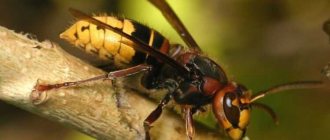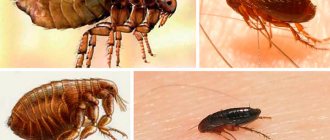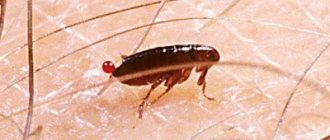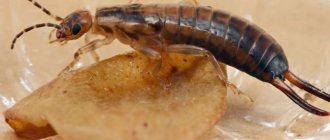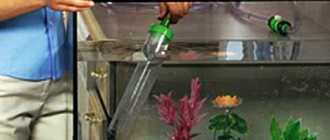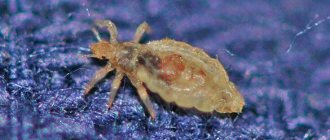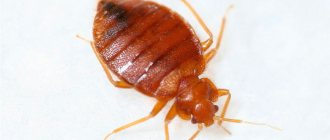When a person encounters a double-tailed dog, he immediately develops associations with painful bites and other negative phenomena. And this is not surprising, since the insect has a very formidable appearance. The pest is identified by characteristic elements such as long mustaches, as well as abdominal appendages in the form of a stove grip.
Having seen such an insect in their apartment or house, the owners try to get rid of it immediately. To do this, it is enough to use bait, homemade traps or chemicals. In any case, it is possible to take advantage of useful advice from experts.
Appearance of two-way
Double-tailed animals have a white elongated body, devoid of pigmentation. Only the cerci, paired outgrowths at the end of the abdomen, may be slightly darkened. In many species they have a menacing appearance and resemble claws.
Forktails are ancient creatures. Scientists believe that their origin began in the Carboniferous period. This may be why these representatives have a primitive structure.
The two-east has no eyes. They are completely blind, but are well oriented in space thanks to their long, segmented antennae. The antennae have a straight, not curved shape and are directed forward. Typically, the antennae are between half and one-quarter the length of the body.
All creatures of this order have 3 pairs of legs. They are colorless and short, starting on the first two segments of the abdomen. The entire abdomen consists of as many as 10 segments - thus, the legs of the double tail are located closer to the head. These creatures do not have wings.
The size of two-easted birds living in Russia does not exceed 2-5 mm. But in tropical countries there are giant individuals with a body length of up to 5 cm.
We know the enemy by sight - the anatomical characteristics of the double tail
The two-tailed forktail is a harmful insect with an oblong body divided into segments and a red-brown color. Moves on six legs. The size of the antennae can reach ½ of the body. The two-tailed bird rarely uses its small wings.
Another popular name for the insect in question is the earwig. It is due to the fact that the two-tailed bird likes to settle in a person’s ear, penetrating there at night.
In place of the tail, chitinous formations grow, which are called cerci:
- in small specimens (from 2 to 3 cm) they are small and relatively thin;
- in two-easts of large size, the length of which exceeds 7 cm, the cerci are distinguished by strength, hardness, and power.
The forktail needs its stings (cerci) to capture and hold its prey. They squeeze their prey like a vice and bend (like scorpions), which makes it easier for the insect to eat.
Habitat
The habitat of the two-east covers middle and tropical latitudes throughout the globe, except for deserts, mountainous and arid areas. The vast majority of representatives of the order live in America, but many species are also found in central Russia.
In nature, doubletails live in moist soil, but avoid wetlands. Their favorite places are fallen, rotting trees, wet slopes near streams and ponds, as well as the lower tier of a dense forest, where the sun's rays do not reach due to dense branches. It is easy to detect double-easted fish if you turn over a rotten snag or dig up the ground on the river bank.
Unfortunately, double-tailed birds often settle near humans. They love rooms with high humidity and poor ventilation, so they can live in basements, bathrooms, and under baseboards. It is not easy to detect uninvited guests, since these creatures leave the shelter only at night. Due to their small size and lack of pigmentation, they are invisible. Therefore, two-tailed birds can live in a house for several years, and the owner will not be aware of their presence.
Information that will help you fight double-tails
Earwigs are easily recognized by their pincer-like mechanism on the back of their abdomen. Although the insect has a rather frightening appearance, these “pincers” are absolutely harmless to humans, however, if the insect is pressed against an unprotected part of its body, it will try to pinch with its peculiar pincers.
By the way, it is precisely for such a “tool” that the earwig earned its second name - mite.
During one warm season, female earwigs lay up to 20-60 eggs in their burrows, the so-called chambers, at a depth of 5 to 8 cm underground. Most species produce one generation per year, which survives the winter in the soil or under the floor in the case of private homes. Both adults and juveniles require large amounts of moisture to survive.
The earwig has some “habits” that are very useful to know for those who deal with these insects:
- Insects are predominantly nocturnal, feeding only at night. They are scavengers, eating mostly dead insects and decaying plant materials.
- Some species of earwigs are attracted to lights, including the common earwig.
- During the day, earwigs will seek shelter under organic layers such as mulch, pine needles, fallen leaves and other similar debris. In addition, insects prefer dark and damp areas, such as under sidewalks, stones, and in foundation crevices.
- Earwigs are able to feed on the tissues of living plants, which can cause damage to garden crops.
- Pests are able to enter your home through entry points such as doors and windows and cracks in the foundation.
- If breeding conditions are favorable for earwigs, they can produce fairly large populations of themselves quite quickly and are often a serious problem in residential areas on the ground.
- Earwigs live in places where millipedes and woodlice also hide, so if you find the latter, you will most likely find earwigs nearby.
Nutrition
Twotails feed on humus, but some representatives are predatory and can catch small insects, crustaceans, springtails and other invertebrates living near them. Predatory species of two-easted (pictured above) have cerci that resemble claws. With the help of these projections they grab and hold prey. Herbivorous two-tails (pictured below) have long and straight tail extensions, since they do not need to hunt for food.
Two-tails also eat mycelium threads, microscopic mites, eggs and larvae of insects, berries, young and decaying shoots. Hexapods feed in the dark, finding food with the help of sensitive antennae. They can take food underground to eat during the day. But when the sun's rays appear on the soil surface, the two-tailed plants do not appear.
Life cycle and reproduction
Two-tailed animals are dioecious animals. In all representatives of the order, fertilization is external: the male deposits spermatophores on the soil, the female finds them thanks to special pheromones - the odors that they emit. The female then collects spermatophores and plunges into the soil. Having prepared a cavity for her clutch, she lays eggs.
Unlike many insects, two-tailed insects do not undergo metamorphosis. The eggs hatch into individuals that look similar to adults, but are smaller in size. However, there are still slight differences in the structure of the little two-tailed birds from their parents: they have fewer segments on the abdomen, and many of their organs are not yet developed.
During the process of growth, two-tails molt - they shed the old chitinous shell and form a new, larger one. This process is due to the fact that the chitinous shell cannot increase with the growth of the host. Therefore, arthropods are forced to change it.
Reproduction of two-easted birds occurs in the warm season. These arthropods are very prolific: the female lays over 100 eggs at a time.
Origin of the species and description
Photo: Two-tailed
This arthropod is included in the class of cryptomaxillary, uniting the most primitive creatures that lead a very secretive lifestyle, and are closely related to the soil, except for the two-tailed, this class includes the non-jawed, springtails. What these three species have in common is that their mouthparts are retracted into the head capsule, hence their name.
Video: Double-tailed
Previously, this subclass belonged to insects, but now it has been identified as a separate class. Individuals of the order Two-East are closest to insects. They are larger than other representatives of the cryptomaxillary species: protur and springtail. How hexapods developed historically is poorly understood. But one species of two-easted fish is known, dating back to the Carboniferous period - Testajapyx. The individuals had compound eyes, as well as a mouthpart similar to that of real insects, in this they are closer to them than to modern representatives of Diplura.
This species has three large groups:
- Campodeoidea;
- Japygoidea;
- Projapygoidea.
The most widespread are:
- family Campodia;
- Japix family.
Natural enemies
The two-easted bird has many enemies in nature. Birds readily peck at them - perhaps this is one of the reasons why these creatures are nocturnal. But danger awaits them in the soil too. Shrews and moles willingly feast on two-tailed fish and destroy their clutches.
These creatures are also destroyed by soil insects, for example mole crickets. The predatory larvae of many beetles also destroy two-easted beetles. But these creatures deftly avoid natural enemies, as they quickly move between particles of the earth thanks to three pairs of short but strong legs.
Two-tailed fish can exhibit cannibalism, eating small fellows of their own or other species. This is especially true for predatory representatives of the order.
What does a double tail look like, photo
The double-tailed bird (also known as an earwig) is an insect from the order Leatherwings, ranging from 7 to 50 mm in length. The double-tailed wing has 2 pairs of wings, but the upper one is shortened and is, rather, a rigid elytra, and the back one is membranous or absent altogether.
The insect got its name (two-tailed) for the characteristic pair of “claws” at the end of the body. The color is dark brown, brown, sometimes black. In the territory of the former USSR, the European earwig (mite) is mainly widespread.
The insect leads a nocturnal, secretive lifestyle. The main diet is organic remains of animal and plant origin, as well as small organisms.
Loves humidity, lives under stones in rotten leaves, as well as in secluded corners of human dwellings.
INTERESTING . There are forktails, which are vaguely similar to earwigs, but these insects represent different orders. Although in the scientific classification it is the forktails that are “real two-tails.”
Does the double-tailed snake bite and why is its bite dangerous?
Predatory representatives of the order are capable of biting a person - squeezing the skin with their claws. The cerci are so strong that this little creature can tear the skin. And since these creatures live in damp, polluted places and feed on fungi and spoiled food, inflammation can develop in the wounds.
The bite of the double tail is quite painful. How can one understand that it was the two-tailed one that bitten if the room was dark or the person did not immediately pay attention to the stabbing pain? There is one characteristic sign: on the damaged area of the skin there will be not one, but two small wounds with a distance of 1-2 millimeters between them. Soon after being bitten, they begin to itch and swell.
What to do if bitten by a two-tailed fish? Fortunately, these creatures are not poisonous. But the wound cannot be ignored. It needs to be disinfected quickly. If a person is prone to allergies, it is advisable to take an antihistamine.
Harm and danger
Insects are not poisonous. They never attack a person unless they feel threatened by him. Insect bites are not dangerous, but they are unpleasant. They do not pose any serious consequences for human health. Redness may occur at the site of the bite. The main danger is the possibility of spreading infection.
In hot, dry summers, earwigs spoil ripe fruits of apples and pears that have fallen to the ground from trees, and eat up the pulp of strawberries. They also feed on the sap of flower plants.
Is double-tailed beetle dangerous for humans?
It is already clear from the previous section that two-tailed animals are by no means harmless creatures for people. But the danger of these creatures lies not only in possible bites.
If two-tails live in the bedroom, theoretically, such a creature could crawl into the ear when a person is sleeping. Once in the ear canal, the double tail will cause severe pain. In this case, boric acid will help. It is dripped into the ear, and soon the two-tailed one dies. A dead arthropod can be easily removed with a cotton swab. If you don’t have boric acid at hand, and some creature is moving in your ear, you can drop sunflower oil into the ear canal. It kills all arthropods, as it quickly fills the trachea through which these creatures breathe.
A repulsive appearance can also harm a person emotionally. The two-tailed bug can greatly frighten a child or a person who is afraid of insects. In addition, these creatures appear suddenly and run quickly, which enhances the frightening effect. And for some, the presence of insects in the house will not allow them to sleep peacefully.
Since two-tailed birds hide in damp and polluted places during the day, they can spread dangerous bacteria. After all, at night, while the owners of the house are sleeping, these creatures can walk around the kitchen table, food and clean cutlery in drawers. The threat lies in the fact that the hostess may not know about the dangerous neighborhood and only wonder why the child got sick or the guests were poisoned.
In the garden, doubletails also cause great harm. In the spring they destroy seedlings, and in the summer and autumn they eat berries, vegetables and fruits. Since arthropods appear at night, the garden owner may not even suspect who is spoiling his harvest. Doubletails love moist soil and therefore well-watered beds are an excellent refuge for them.
Two-tailed and earwig - differences
The two-tailed bird is similar in appearance to the earwig, a representative of insects that has a similar body shape and the same forked cerci at the end of the abdomen. Therefore, the double-easted bird is often confused with the earwig. But in fact, these are different creatures that have little in common in structure and lifestyle.
An earwig, which is confused with the two-tailed earwig.
The earwig is always colored in brownish shades, while the two-tailed one is most often colorless (white) or light beige. There is one more difference: the two-tailed carapace is denser and wider, while the six-legged ones have a soft exoskeleton.
Folk methods of struggle
What means do you use to combat double-tails?
FolkChemical
The most common and widely used folk remedies are herbal infusions. They are prepared from 1 tablespoon of dry herbs and 1 liter. boiling water To combat double-tailed insects, it is better to brew tansy or wormwood. The finished product is applied with a brush to the surfaces of possible insect habitats or sprayed with a spray bottle.
An infusion of onion and garlic effectively repels earwigs from their homes. This product must be left to steep for at least 12 hours before use.
Expert opinion
Mityuk Stefania Bogdanovna
The traditional means of control is any product based on boric acid. Most often, at home, boric acid is mixed with hard-boiled chicken yolk. The product prepared in this way is shaped into balls, after which they are laid out in problem areas.
Is there any benefit from two-way?
There are no useless species in the wild. Two-tailed fish are part of the ecosystem and have a role in maintaining balance within it. These creatures are food for birds, insectivorous animals and invertebrate creatures. In turn, the two-tailed insects themselves also destroy many organisms, including forest pests and dangerous parasites - for example, ticks.
Two-tailed plants also play an important role as saprotrophs - little orderlies. They eat decaying plants, berries and dead insects. This is a very important ecological role, since without saprotrophs the cycle of substances in nature is impossible.
But near human habitation and on agricultural land there is no benefit from two-easters. Therefore, we need to fight them.
Answers to frequently asked questions
Is the earwig poisonous?
No, but her claws may have an infection that causes skin irritation and an allergic reaction.
Is it true that an earwig crawls into the ear of a sleeping person?
On purpose - no. By chance, it can get there just like any other insect.
How to get rid of insects quickly?
Treat the room with an insecticide, clean, ventilate, remove debris and dirt.
Should earwigs be exterminated?
There is almost no benefit from these insects. Yes, they eat aphids, but they are more likely to cause damage to your garden. If you have an apiary, then you need to solve the double-east problem. They love to eat honey.
I don't want to kill insects. How to simply kick two-easters out of the house?
Then use non-lethal traps (for example, with a wet rag) and folk remedies that have a strong unpleasant odor. But you must understand that in this case you will have to constantly kick the two-easter out of the house.
How to get rid of double-east in an apartment and a private house?
If double tails appear in an apartment or country house, first of all you need to examine all pipes and valves for leaks, check the ventilation and humidity level in the room. These creatures do not live in dry and well-ventilated rooms. Therefore, the very fact of the appearance of double tails is a sign that the house is too damp.
By the way, high air humidity is also harmful for the residents themselves. And in addition to small arthropods, a fungus may appear. Taking it out is much more difficult. Therefore, establishing a normal indoor microclimate is the main way to combat pests, which will also help get rid of related problems.
To reduce air humidity, do not dry clothes in the bathroom or kitchen. If condensation accumulates on the pipes, it must be removed regularly with a dry cloth. In addition, it is important to remove all places where two-tailed insects can hide and reproduce: seal cracks with sealant, look through hard-to-reach places under furniture and household appliances. Two-tailed ducks that live in houses and apartments feed on food waste, so the trash needs to be taken out every evening and food must be carefully covered.
In order to get rid of all arthropods in the house, you can use insecticides. But you need to use chemicals carefully if a person prone to allergies lives in the room.
To destroy arthropods without putting your health at risk, you can use special glue. It is applied to cardboard or paper around the delicacy for two-easts. These could be slightly rotten or simply overripe berries, pieces of banana or apple, as well as bread crumbs. The glue is placed overnight in the places where the double-east was found. In the morning they will already stick to the paper, and all that remains is to throw it away. Naturally, before putting out the bait, you need to clean up and remove garbage, all food and crumbs from the table.
But it’s important not to forget about sticky traps. If a child or pet steps on such a surface, it will not be easy to wash off the glue. Therefore, animals should not be allowed into the room, and children should be kept under supervision.
Earwig food - our plants
These animals are omnivores and are not averse to eating vegetables, fruits, berries and flowers in your garden plot, and sometimes on your own table, eating up the leftover food. Therefore, you should take the order on the table and cleaning up after meals very seriously. If you are a lover of ornamental plants, then you have probably often encountered the problem of the death of roses, chrysanthemums, carnations, dahlias and other flowers. The reason for this may be the aforementioned insect pests. The earwig is a burden for the gardener, gnawing everything in its path: leaves, shoots of young plants, flower petals.
